-
A short History
of a Maratha state in the Carnatic that left an indelible mark in the field of
music, drama, dance and literature over a hundred years.
The eighteenth
century was a period of rich accrual to the music, literature and drama of the
south with emphasis on religiosity. The centre of this cultural upheaval was
the state of Thanjavur, where royal patronage to art and learning created new
literary works that live to this day. From late seventeenth century until it
was taken over by the British in 1855, Thanjavur was under Maratha rule, and to
this story we will now turn.
It’s a long way from Pune to Thanjavur. Yet these two far flung cities were the possessions of Shahji raje Bhonsle’s two sons – Shivaji raje and Vyankoji raje. The first stirrings of an independent kingdom of the
Maratha people were discernible in the times of Shahji raje and these became a
reality in the times of his sons.
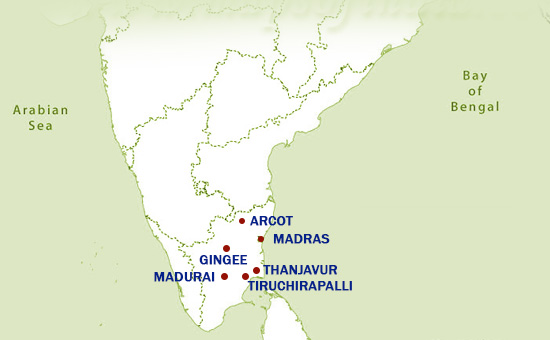 Map Tamil Nadu. Top extreme left is Pune.
Map Tamil Nadu. Top extreme left is Pune.
Thanjavur was
first captured for the Vijayanagar Empire by Kumar Kampana in the mid-14th
century. The three and a half century old Vijayanagar Empire, that stretched
from coast to coast and occupied the peninsula south of the Tungabhadra, broke
into pieces after the cataclysmic battle of Talikota in 1565; a few of its
tributary states in Mysore, Thanjavur, Tiruchirapally and Madurai survived,
albeit as subsidiaries to the Bahmani states of Bijapur and Golconda.
The Adilshahi of Bijapur had amongst its nobles Shahji raje, and he was the lord of Bengaluru in the period from 1636 to his death in 1666. Meanwhile his son Shivaji raja had challenged the might of the Mughal Empire as well as the Adilshahi and forged a strong compact kingdom of his own that stretched from the old jagir of Pune to the Arabian Sea and included many parts of the Konkan coastal strip. In 1674, Shivaji raja became the Chhatrapati, and declared himself a sovereign king, minting his own coins. In 1676 he began the last great campaign of his life – to capture the south and meet his step brother Vyankoji who had inherited Shahji raja’s estate in the south.
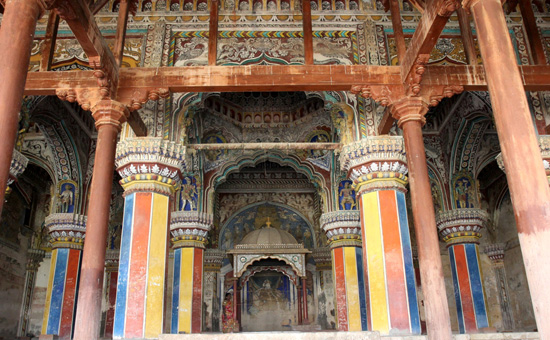 Maratha Palace Thanjavur. Pic by S Nayyar
Maratha Palace Thanjavur. Pic by S Nayyar
Vyankoji had not
been idle. On behalf of Bijapur, he had led an army to Thanjavur in 1676 and
imposed his own rule, evicting the Nayaka ruler of the place. An extremely
fertile plain with its own sea ports, Thanjavur was a prize acquisition. The
consequence was the neglect of Bengaluru and its capture by the Mughals who
sold it to the ruler of Mysore. In 1677, Chhatrapati Shivaji met the Qutb Shah,
who was awed by the mighty Maratha army that entered his city. Relieved by the
friendly overtures of the Maratha king, Qutb Shah readily agreed to lend a part
of his army to accompany the Maratha army on its conquest of the south.
The Maratha army
with Qutbshahi troops, led by Chhatrapati Shivaji, soon captured all the forts
and major towns north of the Cauvery. Just beyond the river lay Thanjavur and
Chhatrapati Shivaji is said to have met Vyankoji and then returned to his camp.
During this time, he rebuilt and strengthened the
fort of Ginjee so that it became the largest and the strongest fort in India
and placing his own trusted officers there, returned to his capital Raigad. The
years 1680 and 1681 were traumatic years for the Marathas. Chhatrapati Shivaji
died in 1680 and Vyankoji, the year after. The two kingdoms followed very
different paths from then onwards.
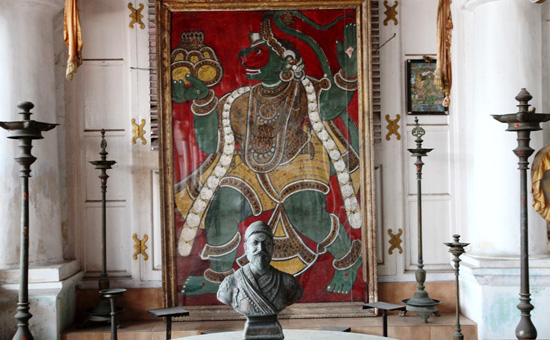 In private museum inside Thanjavur Palace is murthi of Shivaji Maharaj. Pic by S Nayyar
In private museum inside Thanjavur Palace is murthi of Shivaji Maharaj. Pic by S Nayyar
In Thanjavur, Vyankoji’s three sons succeeded him one after another. Shahji, the eldest was a connoisseur of the arts and not just patronised Sanskrit, Marathi, Telugu and Tamil literature and drama but was an author and poet in his own right. There are at least twenty plays in Telugu attributed to Shahji alone, which were of the Yakshagana form and the Veethi Nataka
which was a kind of popular street play. Similarly, his brother Tukoji composed
two poems.
The Carnatic
invaded by the Mughals after 1690 faced considerable turbulence as the war with
the Marathas centred around Ginjee fort. The Mughals suffered several reverses
as flying parties of Marathas led by their Senapati Santaji Ghorpade and
Dhanaji Jadhav attacked the slow moving columns and instilled a fear of attack
not just in the troops but their animals. The Chitnis bakhar speaks of the
beleaguered Mughal, ‘when the Mughal trooper’s horse brought to water, refused to drink, the trooper would say, ‘do you see Santaji and Dhanaji in the water?’ The eight-year long siege of Ginjee finally led to Chhatrapati Rajaram’s escape to Maharashtra followed by the capitulation of the fort to Zulfiquar Khan’s army in 1698.
Thanjavur was brought under Mughal rule thereafter and as Aurangzeb withdrew his forces back into Maharashtra, he appointed several ‘Nawabs’ in the Carnatic, of which Arcot was given the authority to levy a tribute on Thanjavur and Tiruchirapalli. The Thanjavur state had an army but remained within its limits and until 1732, the situation remained stable. In 1732, the Indian political landscape had changed completely. The Mughal ‘Emperor’ Muhammad Shah Rangeela was a cipher, the Maratha power extended from the Chambal to the Tungabhadra and the Nizam had been defeated at Palkhed by Peshwa Bajirao. The new political order meant the Maratha king Shahu could once again look southwards.
In 1732, Sadatullah Khan, the Nawab of Arcot died and was succeeded by Dost Ali. The family Nevayat, to who the Nawab belonged, were migrants from Iraq and their service in the Mughal army saw them rise in the Mughal army. Dost Ali’s son Safdar Ali and son in law Chanda Sahib were ambitious young men desirous of carving out their own domains resulting in an intense rivalry between them. The death of Tukoji, the last son of Vyankoji in 1736 saw an invasion of his kingdom while Chanda Sahib also cast his eyes on Tiruchirapalli. The events led to messages being sent to Shahu in Satara to send his army to help his cousin at Thanjavur.
The next three or four years were difficult times for Thanjavur and the Nayaka kingdoms of Tiruchirapalli and Madurai. The Nevayats all but annexed these Hindu principalities. Asaf Jah, the Nizam of Hyderabad, who was the overlord of Arcot was away in Delhi. In 1738, Bajirao had dealt him another defeat at Bhopal and the following year the invasion of Nadir Shah had left him in knots trying to save himself and the deposed Emperor Muhammad Shah. Bajirao himself was engaged in a battle with the Nizam’s son around Aurangabad. Shahu therefore could not succour Thanjavur until 1740. That year, he dispatched an army of forty thousand men under Fateh Sinh and Raghuji Bhonsle of Nagpur to the south.
The huge Maratha
army wended its way south, crushing the pathan Nawab of Kurnool on its way. As
it approached Arcot, Dost Ali summoned Safdar Ali and Chanda Sahib to his help.
However, these two came too late. At the pass of Damalacheruvu north of Arcot,
the Maratha army confronted the Nawab and asked him to submit. On his refusal,
a battle was fought where the Nawab and his youngest son lost their lives. The Marathas occupied Arcot and marched on Tiruchirapalli.
Safdar Ali took refuge in Vellore, while Chanda Sahib returned to
Tiruchirapalli. Their treasure and their wives they dispatched to Puducherry
where the French gave them refuge. Pratap Sinh, the then ruler of Thanjavur was
freed from the clutches of Chanda Sahib.
Safdar Ali then formed a secret pact with the Marathas against Chanda Sahib, for which he promised an indemnity of a crore of rupees. The Marathas appeared to withdraw to the north in August 1740, however, they were merely biding their time. The death of Bajirao had led to Raghuji Bhonsle’s dash back to Satara where he tried to prevent Nanasaheb, Bajirao’s eldest son, from being appointed the Peshwa. However, Shahu did not listen to Raghuji’s counsel and at the end of the monsoon, Raghuji was back in the south.
Raghuji next appointed
Safdar Ali as the new Nawab of Arcot and moved his army towards Tiruchirapalli.
The town was taken and the Rock fort was besieged for three months. Chanda Sahib
summoned his brother Bade Sahib for help from Madurai. In a sanguinary battle
that lasted nine hours and costing three thousand lives on both sides, Bade
Sahib was killed. Tiruchirapally fort was then captured by escalade and Chanda
Sahib imprisoned and dispatched to Nagpur. He was in Maratha prison for the
next eight years.
Thanjavur
breathed a sigh of relief with the disappearance of Chanda Sahib. The Tiruchirapalli fort was given to Murar rao Ghorpade
to look after and the Maratha army returned to Satara. The chauth of
Arcot was to be remitted annually by Safdar Ali. However, the arrangement did
not last for long. In 1743, Asaf Jah descended on the south with a huge army of
two hundred thousand men, subdued Thanjavur and placed Tiruchirapalli fort in a
siege for nearly six months without success. Finally, negotiations were held
and Murar rao was given the option of taking over the alternative fort of
Penukonda while retaining his base at Gooty. Thanjavur once again was at the
mercy of the new Nawab Anwaruddin.
Anglo French disputes began to flare up in the mid-1740s and it was impossible for the regional players to stay aloof. With Dupleix as the Governor at Puducherry, the French stole a march over their rivals and for a while even captured Madras. The death of Asaf Jah in 1748, the assassination of his son Nasir Jung as well as that of the French supported Muzaffar Jung, led to further instability in the Carnatic. Chanda Sahib was released by the Marathas, but in those turbulent times, he succumbed to an attack by a pathan. It was the French General M. Bussy who was in charge of the Nizam’s army at this time, and he quickly proclaimed Salabat Jung as the new Nizam, thereby placing the Deccan firmly under French control. The decade of the 1750s saw three wars between the Marathas and the Nizam’s army led by Bussy which did not change the situation on the ground appreciably. The Maratha presence in the Carnatic was held by Murar rao Ghorpade.
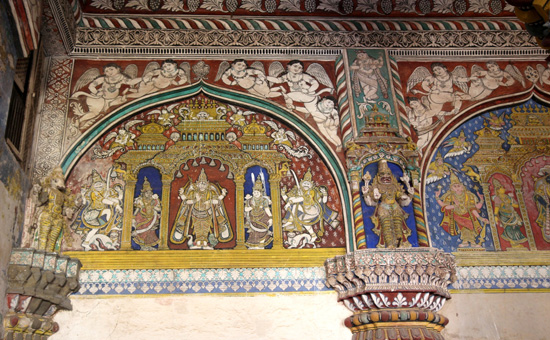 Inside Maratha Palace Thanjavur. Pic by S Nayyar
Inside Maratha Palace Thanjavur. Pic by S Nayyar
It was in 1756
that Nanasaheb Peshwa came marching down to Srirangapatnam. The Nawab of
Cuddapah was killed in battle and the Maratha General Balwant rao Mehendale
came down as far as Vellore. With the English the weaker side, they quickly
stitched up an alliance with the Marathas against the French. Thanjavur was
part of this alliance and in 1757, the French under their General Lally captured
Fort St. David from the English and came up against Thanjavur.
The English came late to the party and Robert Clive was the man who stamped his presence on the scene by taking Arcot from the French and defending the Rock fort of Tiruchirapalli held by their ally Muhammad Ali. The Marathas were at this time increasingly drawn into the politics of the north and Bengal, rendering help to Thanjavur practically impossible. From 1758 to 1761, the Anglo French rivalry played out until finally in January 1761, two days after the battle of Panipat, Puducherry was taken by the English under their General Eyre Coote. There was no looking back for the English after that in the south. Puducherry’s defences were completely destroyed by the English in the months after occupation. In the run up to the final battle, the English outbid the losing French side in paying the Maratha army ten lakh rupees to stay out of the fray.
The Thanjavur
rulers had been in alliance with the English as had Nawab Muhammad Ali of
Arcot. Thanjavur was placed under the Nawab and an annual indemnity was levied
on the raja. However, further huge payment for protection afforded to Thanjavur
during the war was demanded. In the 1760s, the riches of Thanjavur were once
again sought by the Nawab and the English when there was war with Hyder Ali of
Mysore. Although Thanjavur had sent an army, the Nawab demanded more money to
defray his expenses. Eventually an English force landed at the fort of
Thanjavur and demanded a sum of 32 lakh rupees as expenses for the war.
In 1774, a similar expedition went to Thanjavur demanding more money. The Raja of Thanjavur was deposed due to his inability to pay. However, the Directors in London reversed the situation when they took the Raja of Thanjavur out of the Nawab’s control and placed him under their own. In 1775 therefore, the Raja of Thanjavur became a subsidiary of the East India Company.
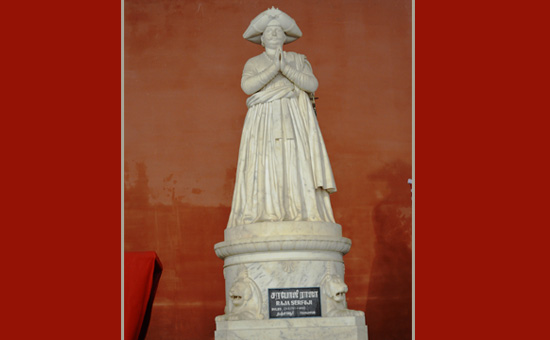 Serfoji was appointed Raja 1786. Pic by Uday S Kulkarni.
Serfoji was appointed Raja 1786. Pic by Uday S Kulkarni.
In 1786, Raja Tulaja of Thanjavur, who had strenuously protested the injustice against him, and succeeded in retaining his patrimony, died. His adopted son Serfoji was young and another son by a concubine named Amar Sinh was appointed as the Raja. However, by 1798, the English were in control of most of Indian power structures. They decided to place Serfoji as the king. Serfoji was given a progressive education by a tutor named Schwarz. Serfoji learned several languages and became a patron of scholars. He enlarged the the Saraswati Mahal Library at Thanjavur which even today boasts over forty thousand rare manuscripts.
Serfoji was the last of the Bhonsle rajas of Thanjavur. For long the rulers of Thanjavur had been devoid of any real power. Serfoji died in 1832. His only son Shivaji ruled until 1855, however, he had no male successor. Thanjavur then became a casualty of Lord Dalhousie’s infamous ‘Doctrine of Lapse’ and was absorbed into British ruled Indian provinces.
The story of the
Maratha kingdom of Thanjavur is not merely a political one. Thanjavur was the fountainhead of culture, music, drama
and literature for over a century.
The rajas were true
patrons of the arts. The Bharatnatyam dance form of this day is not more than
three centuries old and owes its origin to the Dasiyattan or Thanjavur natyam patronised during the Maratha period. The
devadasi tradition perpetuated the music and dance forms and enriched them with
new additions.
The famous
musician Tyagaraja belongs to this late eighteenth century period of southern history. In Serfoji’s court one finds the famous four brothers who gave form to the Bharatnatyam dance. From here it spread to Travancore and Mysore.
Painting was
another art form that received royal patronage and we find portraits of the
kings from Shahji raje onwards. Many royal buildings such as the darbar hall,
and many chowltries for travellers were built across the state.
The Saraswati
Mahal Library was inherited from the earlier Nayakas and enlarged with many new
documents and paintings to make it a rich repository of knowledge.
The British
takeover of Thanjavur after 1800 ended the patronage to art from the central
monarch. Smaller chiefs continued to lend their support thereafter, and
gradually it moved to the common people from the aristocracy and the devadasis.
Thanjavur today
is known for its rich contribution to south Indian culture and although its
political significance dwindled all through the eighteenth century, the kingdom
left a mellow and rich heritage behind that scholars can study to this day.
References
1 Brihadeshwar
temple inscription.
2 Maratha rajas
of Thanjavur by KR Subramaniam.
3 Maratha Supremacy – Bharatiya Vidya Bhavan.
4 Contribution of Marathas of Tanjore to Art and Architecture – Dr N. Neela and Dr. G Ambrosia (Shanlax International Journal of Arts, Science & Humanities Jan 2016).
5 Lectures by CS Srinivasachari at Osmania University.
To read all
articles by Author
Also see
pictures of
1 Maratha
Palace Thanjavur
2 Art
Gallery Maratha Palace Thanjavur
3 Shivaji
Temple Chennai
4 Big
Temple Thanjavur